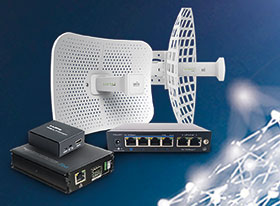

Infrastructure such as cabling (copper and fibre) will last between 10 and 20 years and is the lifeblood of the network and as such, must be able to handle both the current and future bandwidth demands. In security networks these include the likes of Ultra HD video and voice transmission, database access or backup, and storage that may only be replaced every second or third network refresh cycle.
In earlier years, many installations shied away from using wireless as a transmission medium due to latency and reliability issues. The modern wireless systems now offer secure, multi frequency, low latency and transmission speeds in excess of 300 Mbps and at distances up to 10 km, thus making them ideal for long distance transmission where cabling is not possible or may prove too costly. Wireless deployments should always be subjected to a detailed site survey to confirm line of site, operating distances and potential sources of interference.
Bandwidth and throughput requirements are key metrics for switching and routing design in order to match up the hardware with the infrastructure, thus avoiding bottlenecks and ensuring the shortest route possible for the data packets. The best designs will always include a 25% headroom for future growth and peak network demand.
Risk assessments have indicated an increase in physical and cybersecurity attacks which has forced organisations to re-evaluate their risk profiles and prioritise spending on mission critical hardware. This, along with the advancement of IoT, AI and the need to automate manual tasks such as screening, monitoring, vetting and granting access, has led to the evaluation of current systems and processes.
It is now more critical than ever that all physical and digital entry points into an organisation are assessed for vulnerabilities such as weak and default passwords, unsupported and unpatched hardware and software, unsecured infrastructure such as network cabinets and wall jacks. Personal devices and remote access should form part of this assessment.
Replacement need not necessarily be a wholesale ‘rip and replace’ exercise, but rather a phased approach based on the risks evaluated and identified. Options include upgrades and security patches, reassigning existing equipment where bandwidth and throughput requirements remain low, migrating to a cloud-based solution and equipment rental as an operational budget.
Finally, ensure that you build redundancy and load balancing into your security network by splitting cameras and access control over multiple recorders, controllers and switches so that in the event of failure or damage you still have your key monitoring areas and perimeters covered.
| Tel: | +27 11 553 3300 |
| Email: | [email protected] |
| www: | www.regalsecurity.co.za |
| Articles: | More information and articles about Regal Distributors SA |
© Technews Publishing (Pty) Ltd. | All Rights Reserved.